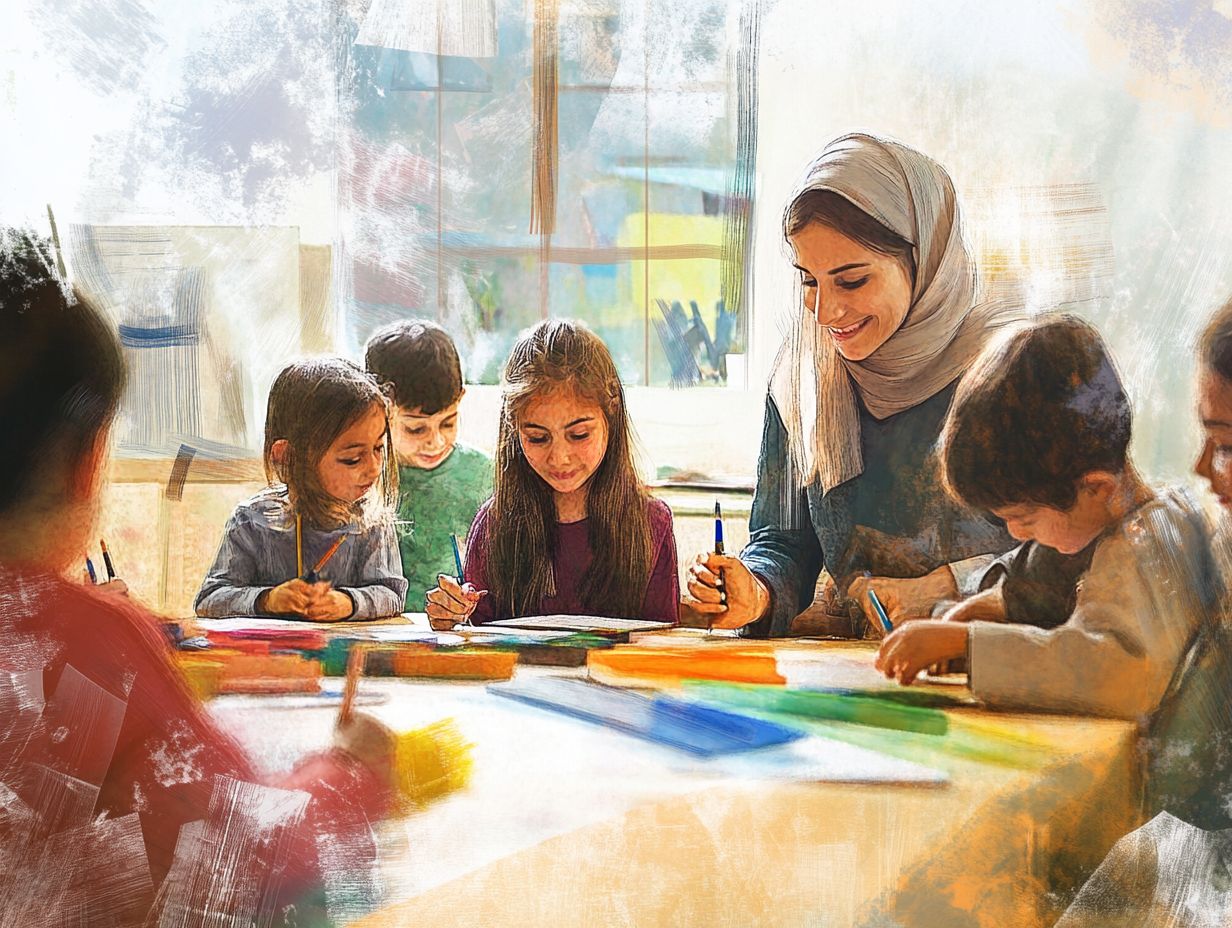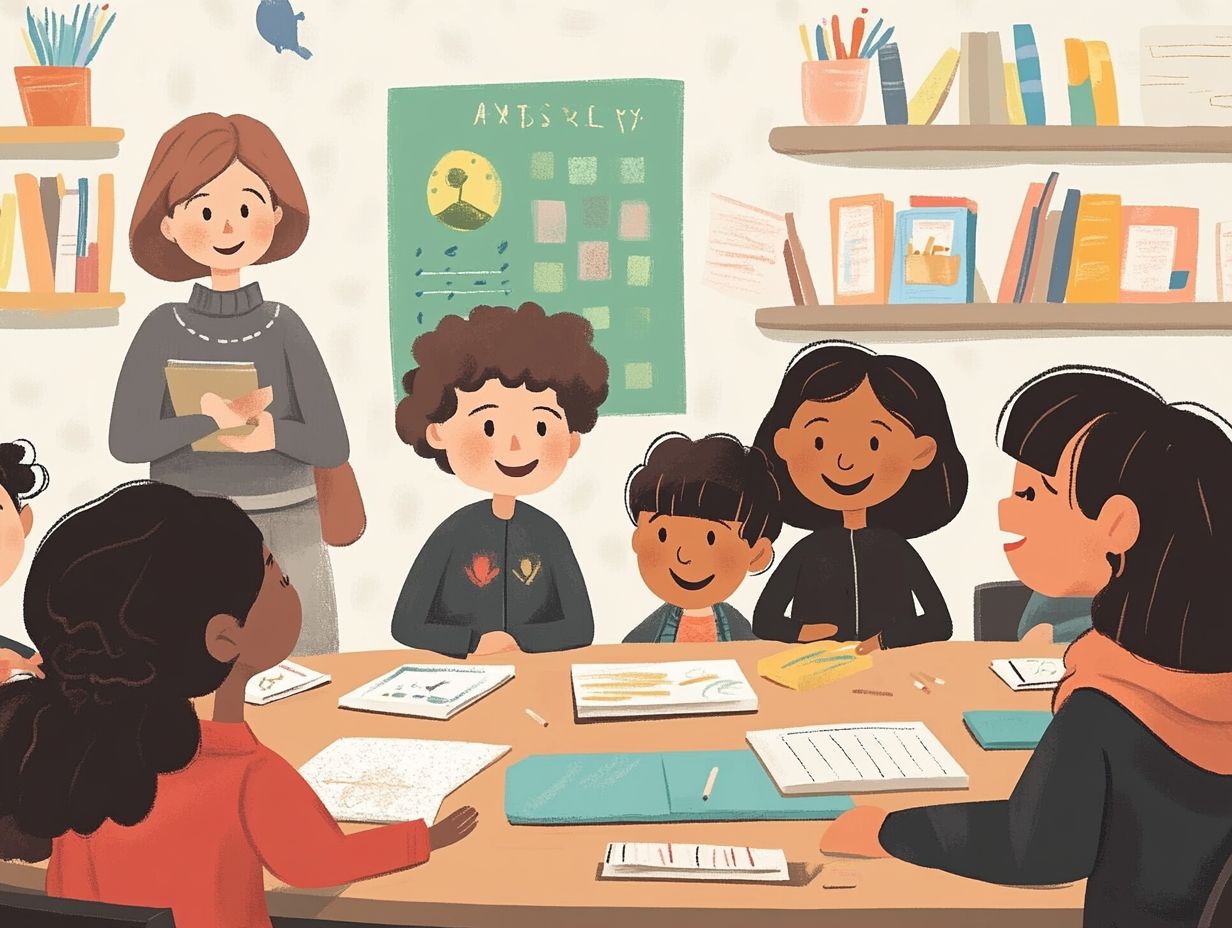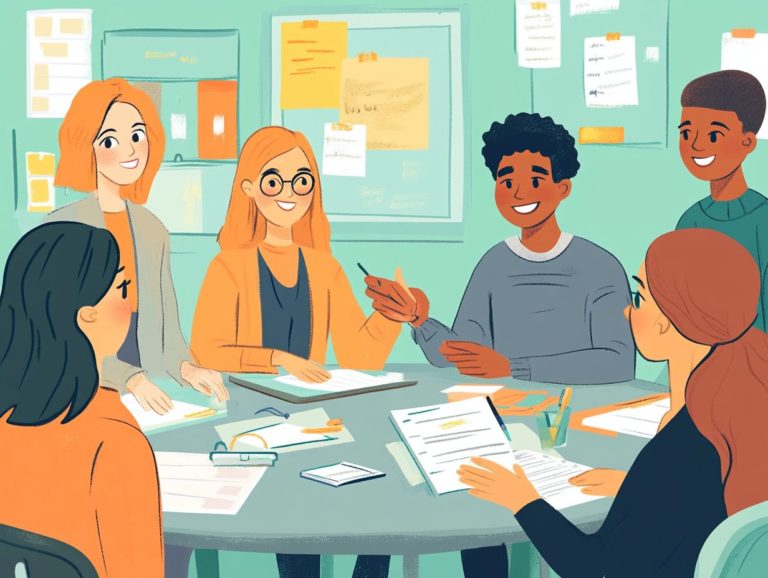Understanding the Needs of Diverse Learners
In today s educational landscape, it’s essential for you to recognize and address the diverse needs of learners. This article delves into the various factors that influence learning, such as cultural backgrounds and individual abilities.
You’ll discover strategies to create inclusive environments, adapt your teaching methods, and engage families and communities in the learning process.
The challenges faced by diverse learners are significant, but here, you’ll find practical solutions to promote equity and inclusion.
Discover how you can create an exciting and enriching educational experience for every student right now!
Contents
- Key Takeaways:
- Factors that Affect Learning
- Strategies for Meeting Diverse Learners’ Needs
- Challenges and Solutions for Diverse Learners
- Frequently Asked Questions
- What does it mean to understand the needs of diverse learners?
- Why is it important for teachers to understand the needs of diverse learners?
- What are some common challenges faced by diverse learners?
- How can teachers address the needs of diverse learners in the classroom?
- What are some strategies for effectively understanding and meeting the needs of diverse learners?
- What resources are available to help teachers better understand the needs of diverse learners?
Key Takeaways:

- Recognize that diversity in learning encompasses cultural backgrounds and individual needs, and adapt teaching methods and materials accordingly.
- Create an inclusive learning environment by collaborating with families and communities and promoting equity for all learners.
- Address barriers to learning and promote inclusion by understanding and valuing the unique needs and abilities of each diverse learner.
Defining Diversity in Learning
Defining diversity in learning means recognizing and addressing the unique needs of diverse learners, who come from various cultural backgrounds, learning styles, and abilities. As you strive to create an inclusive atmosphere in your educational setting, it’s crucial to implement instructional resources that cater to all students, including those with Individualized Education Programs (IEPs) and Section 504 plans that provide support for students with disabilities.
This approach not only enhances student engagement but also aligns with the principles of Universal Design for Learning (UDL), which is a teaching approach that aims to optimize teaching for all individuals by providing multiple means of engagement, representation, and action/expression, ensuring quality instruction for every learner and fostering a genuine sense of belonging in the classroom.
Incorporating tools like Google Classroom and Flipgrid can significantly enhance the adaptability of your instructional practices. For instance, Google Classroom enables you to create tailored assignments that accommodate various learning styles, allowing students to progress at their own pace. Meanwhile, Flipgrid gives the power to students to express their understanding through video, encouraging creativity and verbal expression.
These platforms also offer valuable chances for collaboration and peer feedback, which are essential for supporting diverse learners. Continuous professional development is vital for you as an educator; it equips you with the skills and strategies necessary to effectively respond to diverse learning needs, ultimately elevating student success and achievement.
Factors that Affect Learning
Multiple factors profoundly impact learning outcomes for diverse learners, including their unique learning differences, individual needs, and the broader classroom environment. Each of these elements plays a crucial role in shaping student engagement and determining the effectiveness of instructional practices.
By recognizing the varied backgrounds and specific challenges faced by students, you empower yourself to customize effective classroom management strategies and refine your teaching methods. This thoughtful approach ultimately elevates educational outcomes for every learner in your care.
Cultural Background and Learning Styles
Cultural background plays a pivotal role in shaping how you learn and engage with educational content. When educators embrace culturally responsive teaching practices, they recognize these differences and implement engagement strategies that resonate with your unique experiences.
By accommodating various learning preferences, they create an environment that encourages your autonomy and fosters inclusivity in the classroom.
Understanding the rich tapestry of cultural backgrounds allows educators to tailor their instructional methods to better meet your needs. Utilizing techniques such as cooperative learning groups, differentiated instruction, and culturally relevant materials can transform the classroom into a more engaging space for you.
Incorporating diverse perspectives into lesson plans not only validates your identity but also promotes critical thinking and collaboration. This approach encourages you to share your viewpoints, enhancing overall classroom dynamics and cultivating a sense of belonging. By prioritizing inclusivity, educators elevate your learning experience and motivate you to participate actively.
Start today by implementing these strategies in your classroom for a more inclusive and engaging learning environment!
Individual Needs and Abilities

Recognizing your individual needs and abilities as a diverse learner is essential in creating an inclusive educational environment. By implementing accommodations and modifications designed for your learning challenges, you ensure that you receive the support necessary to thrive academically.
Embracing differentiated instruction allows educators to effectively address your unique needs. This provides quality instruction that promotes your success. When educators understand the distinct challenges you face, they can implement targeted interventions that enhance your academic performance, self-esteem, and motivation.
Collaborative teaching approaches are key in this process. They encourage educators to share strategies and insights, enriching your learning experience. Involving specialists, like counselors or learning strategists, further strengthens the support systems available to you.
As a result, these tailored interventions create a pathway for you to engage meaningfully, improving overall outcomes and fostering a genuine sense of belonging within the classroom.
Strategies for Meeting Diverse Learners’ Needs
Implementing effective strategies to meet the diverse needs of learners is crucial for cultivating an inclusive classroom environment. When teachers collaborate, they pool their resources and insights, enriching instructional practices that cater to every student.
By embracing flexible teaching methods like project-based learning and teaching materials that adapt to students’ needs you can design engaging activities that motivate students and significantly enhance their academic success.
Creating an Inclusive Learning Environment
Creating an inclusive learning environment is essential for promoting student engagement and fostering a sense of belonging among diverse learners. This requires implementing instructional practices that recognize and value each student’s unique contributions.
Strategies like cooperative learning and peer support can significantly enhance student interactions and deepen understanding, ultimately leading to improved educational outcomes. To cultivate this inclusive atmosphere, start by establishing clear expectations for behavior that celebrate respect and collaboration.
For example, developing classroom norms together with your students encourages a sense of ownership and accountability. Employing diverse resources, such as multicultural literature or varied learning materials, makes lessons more relatable and helps all students feel represented and valued in their educational journey.
Engagement strategies like think-pair-share activities foster communication and allow students to learn from one another’s perspectives. Ask yourself: How do my current practices support inclusivity?
Adapting Teaching Methods and Materials
Adapting your teaching methods and materials is crucial for delivering a rigorous educational experience that meets the diverse needs of your learners. To ensure quality instruction, you must be skilled at utilizing various instructional tools and resources that align with your students’ learning styles.
For instance, incorporating technology such as smart boards that allow you to write and draw digitally and educational apps can actively engage visual and kinesthetic learners. Meanwhile, audio resources cater to auditory learners. Learning management systems offer a platform for differentiated instruction, allowing you to create individualized learning paths tailored to each student’s needs.
Regular formative assessments, like quizzes or peer reviews, enable you to gauge comprehension continuously. This makes it easier to spot students who may need additional support. By embracing these strategies, you can cultivate a more inclusive environment that promotes equity and drives learning for all your students.
Collaborating with Families and Communities

Collaborating with families and communities is essential for enhancing student success and improving educational outcomes for diverse learners. When you engage effectively with families, you create a supportive environment that complements classroom efforts and underscores the importance of education across various cultural contexts.
By actively reaching out to parents and local organizations, you foster a network of support that not only motivates students but also honors their unique backgrounds. This open dialogue invites families to take part in the educational journey, sharing valuable insights that can shape teaching strategies and address the specific challenges learners encounter.
Community involvement can offer vital resources, like mentorship programs and extracurricular activities, enriching the learning experience and bridging gaps in understanding. Together, these strategies cultivate an inclusive atmosphere where every student feels valued and gives them the power to thrive.
Challenges and Solutions for Diverse Learners
Diverse learners frequently encounter a range of challenges in educational environments, particularly in the context of the ongoing teacher shortage and the myriad learning obstacles they face. These issues not only affect student accountability but also impede educational institutions’ capacity to deliver customized support to each learner.
Recognizing these barriers is crucial, as is the development of comprehensive solutions that foster equity and inclusion for all students.
Addressing Barriers to Learning
Addressing barriers to learning is crucial for ensuring that you, as a diverse learner, have equitable access to education. Interventions like accommodations and personalized support can help students overcome learning differences, providing you with the necessary tools to thrive academically. It s essential for educators to be proactive in identifying and tackling these barriers to foster an inclusive and supportive learning environment.
These barriers might include thinking challenges, language differences, and social-emotional issues that hinder your engagement and comprehension. For instance, if you have dyslexia, you may struggle with reading fluency, while English language learners might find complex vocabulary and idiomatic expressions particularly challenging.
Effective interventions could involve using assistive technology, implementing tailored reading programs, or engaging in collaborative group work that encourages peer support. Individualized Education Plans (IEPs), which are tailored educational plans for students with specific needs, can significantly enhance your learning experience by outlining specific goals and accommodations.
Ongoing monitoring is crucial! This ensures students get the support they need to succeed as they steadily progress and ultimately overcome the challenges they face in their educational journey.
Promoting Equity and Inclusion
It s vital to promote equity and inclusion in schools to support our diverse learners! Culturally responsive teaching practices are pivotal in creating an atmosphere that honors and respects the contributions of every student. By implementing equitable policies and robust student support, you can ensure that each learner has the opportunity to thrive academically.
To achieve this, incorporate materials that reflect diverse cultures and perspectives to enrich the learning experience. Consider adopting various strategies such as differentiated instruction, which tailors learning experiences to suit individual needs.
It s equally important to cultivate a sense of belonging by actively engaging families and communities in the educational journey. Successful initiatives, like mentorship programs for underrepresented students or inclusive curriculum frameworks, illustrate that when educators prioritize cultural contexts, they not only enhance student engagement but also foster a richer, more dynamic learning environment that uplifts everyone involved.
Frequently Asked Questions

What does it mean to understand the needs of diverse learners?
To understand the needs of diverse learners means to recognize that students come from various backgrounds, cultures, and abilities. Teachers must adapt their strategies to meet each student’s individual needs.
Why is it important for teachers to understand the needs of diverse learners?
Understanding diverse learners promotes inclusivity and equity in the classroom. It helps students feel valued, supported, and enhances their academic and social-emotional outcomes.
What are some common challenges faced by diverse learners?
Diverse learners often face challenges like language barriers and learning disabilities. They may also experience cultural differences and socio-economic disparities.
How can teachers address the needs of diverse learners in the classroom?
Teachers can create an inclusive learning environment by being culturally responsive. Using differentiated instruction and collaborating with families and support professionals is essential.
What are some strategies for effectively understanding and meeting the needs of diverse learners?
To meet the needs of diverse learners, teachers should use various instructional methods. Providing accommodations and regularly assessing student progress is crucial for adjusting instruction.
What resources are available to help teachers better understand the needs of diverse learners?
Teachers can access numerous resources, including professional development workshops and online courses. Instructional materials and support networks like teacher groups can also be beneficial.






